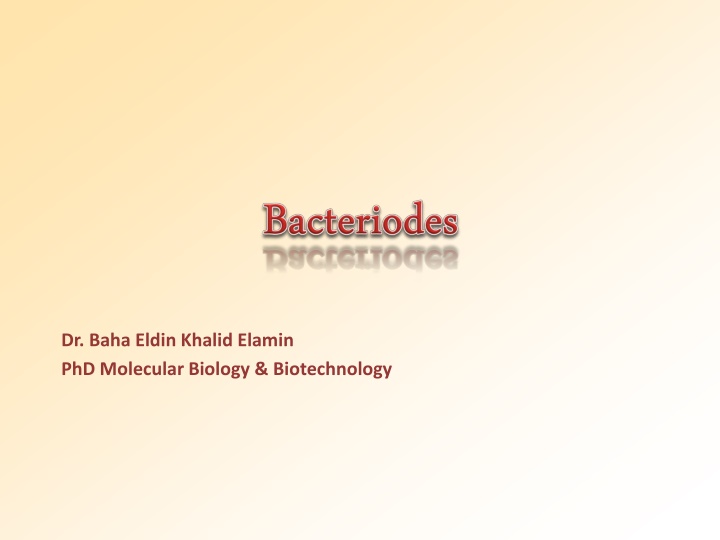
Anaerobic Bacteria: Pathogens and Mechanisms
Explore the world of anaerobic bacteria, including methods for excluding oxygen, anaerobiosis mechanisms, anaerobic bacterial pathogens, and the significance of non-sporeforming anaerobes in infections. Learn about Bacteroides fragilis, a common anaerobic isolate, its virulence factors, and resistance patterns.
Uploaded on | 0 Views
Download Presentation

Please find below an Image/Link to download the presentation.
The content on the website is provided AS IS for your information and personal use only. It may not be sold, licensed, or shared on other websites without obtaining consent from the author. If you encounter any issues during the download, it is possible that the publisher has removed the file from their server.
You are allowed to download the files provided on this website for personal or commercial use, subject to the condition that they are used lawfully. All files are the property of their respective owners.
The content on the website is provided AS IS for your information and personal use only. It may not be sold, licensed, or shared on other websites without obtaining consent from the author.
E N D
Presentation Transcript
Dr. Baha Eldin Khalid Elamin PhD Molecular Biology & Biotechnology
Methods for excluding oxygen 3. Anaerobic glove chamber 1. Fluid media containing fresh animal tissue or 0.1% agar containing a reducing agent, thioglycollate. 2. Anaerobic jar
Anaerobiosis Anaerobic bacteria will not grow in the presence of oxygen. Possible mechanisms: 1) Lack of cytochrome systems for the metabolism of O2. 2) Short of superoxide dismutase. 3) Short of catalase. 4) other unknown mechanisms. Ability of anaerobes to tolerate oxygen or grow in its presence varies from species to species. Most anaerobic clinical isolates are moderately obligate anaerobes, and have small amount of both catalase and superoxide dismutase.
Anaerobic bacterial pathogens Non-sporeforming anaerobes Bacteroides spp., Fusobacterium spp., Porphyromonas spp., Prevotella spp., Veillonella spp., Actinomyces spp., Propionibacterium spp., Peptostreptococcus spp. Sporeforming anaerobes Clostridium spp.
Non-sporeforming anaerobes 1. Non-sporeforming anaerobes constitute the predominant part of normal indigenous flora in human body. 4. Most infections caused by them are mixed, containing 5-6 species or more, including both anaerobes and facultative anaerobes (synergism). 2. Diseases caused by them are usually not transmissible and arealmost autoinfection. The result is usually tissue necrosis and abscess formation. 5. In most cases, treatment requires drainage of the purulent material and appropriate chemotherapy (e.g., metronidazole, clindamycin, etc.) 3. Types of infections are related to the normal endogenous location of the bacteria (Table 42-1).
Bacteroides fragilis Pleomorphic in size and shape; capsulated. Aerotolerant; growth is stimulated in 20% bile. Constitutes less than 10% of Bacteroides species in the normal colon, however, is the most common isolate of anaerobes from infections (intra-abdominal, gynecologic, and skin and soft tissue infections; bacteremia.) Major virulence factor: capsular polysaccharides, which may cause abscess formation when injected into the rat abdomen. Its LPS lacks endotoxin activity. The clinical signs of sepsis (fever & shock) could be due to other components. Resistant to penicillin.
